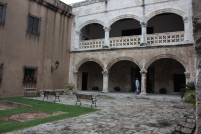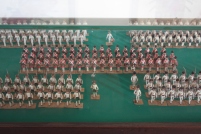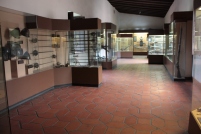I think I’ve settled on a schedule for posting, every 14 days +/- 1 day. It’s sort of like bi-monthly, but I will have a minimum of 26 posts instead of 24. I’m hoping to have more than the minimum, but that will depend on whether I actually get to go on vacation or not. As promised, time for a destination switch to the Dominican Republic to change things up. My usual travel buddy and I visited…
Museo de las Casas Reales, located in Santo Domingo, Dominican Republic
(Museum of the Royal Houses)
The Museum of the Royal Houses is open Tuesday to Saturday from 9am to 5pm and Sunday from 9am to 4pm. Museums in the Dominican Republic don’t seem to advertise their operating hours, so I’m not positive about the hours, just don’t go too early or too late and definitely don’t go Mondays. Mondays appear to be rest days as many sites are closed. Admission is 100RD, which equals to 2-4USD, depending on your exchange rate. An audio guide in several languages, including English, is included with the admission, so make sure to get the audio guide if your Spanish is limited. My travel buddy and I stayed in the Zona Colonial in Santo Domingo, so we walked everywhere in the area; we only needed our legs and a good map to get where we wanted to go. (My buddy and I got a quick tour of the Zona Colonial via the Chu Chu Colonial. You get driven around the area, and they point out areas of interest. It about 45 min long, costs 15USD, and is a good way to figure out how to navigate the area without a guide.)
The museum building was built in the 1500s and served as the office for centuries of aristocracy on the island, thus the building is something to marvel at. The Museum of the Royal Houses covers the history starting in 1492 when the island became the site of the first European settlement in the Americas to 1821 when the Dominican Republic became independent. The museum layout proceeds in a chronological order, thus the first room visited focuses on the early history of the island of Hispaniola, which is shared by the Dominican Republic and Haiti. Various items relating to Christopher Columbus (known as Cristobal Colon in Spanish) are on display, including models of his 3 ships: the Nina, the Pinta, and the Santa Maria, and a map of his various voyage routes to the Americas. Also on display are various instruments used for sea navigation, and information on numerous Spanish conquistadors. Various objects relating to Tainos, the people who inhabited the island pre-Columbus, and their culture are also part of the exhibit. (All the written descriptions are in Spanish, so I can only infer the meaning of some.)
In the next room, visitors can learn about the history of pirates in the Caribbeans. The Spanish Crown imposed a commercial monopoly on the Indies, however other powers of the time, England, France and Holland were opposed to the monopoly, thus they traded by means of contraband, supporting the presence of pirates in the Caribbean. The Spanish built walls in main ports and established a fleet system to protect the trade routes to counteract the pirates, however the fleet system didn’t work out too well, and the Spanish Crown established free trade in some ports. Visitors are introduced to the main products, rum and tobacco, that sustain the local economy and how they are obtained. There is also a brief history on the horrors of the slave trade and slavery on the island.
The museum is housed in two interconnected buildings, so there is a courtyard where visitors can have a seat and take a break before venturing further. Next is the room that served as a pharmacy. The pharmacy has a very interesting medicinal herb cabinet; back in the day, not everyone was literate, so in addition to labels, images were drawn onto the drawers so that everyone could figure out what was in each drawer. (I find this interesting because medicinal users would actually be able to call up an image when they think of the plant instead of it being just a name.) Finishing on the first floor, visitors are introduced to the various forms of transportation that was available during Spanish colonial times.
The second floor of the museum is comprised of several rooms that are dedicated to highlighting the lives of the aristocracy. The first room visited was the Royal Audience Hall, which is staged to reflect what the first court of the New World looked like. The next room is the Great Throne Room and Receptions, which contains a variety of furniture and decorations that were used during Spanish colonial rule. Visitors can also view the Captains General office, which is where previous government officials conducted business. Following is a room filled with art work relating to various notable sites in Santo Domingo.
Also located on the second floor are various collections that the museum has. First is the Historical Ceramology collection where visitors can see a variety of plates, bowls, pots and vases. Next is the Military Aides collection, which contains a soldier’s uniform, banners, and a series of figurines and paper dolls illustrating different types of uniforms. In the final room, connected to the others by an outdoor hallway is the weapons collection. The weapons collection belonged to Trujillo, former Dominican Republic dictator, and contains weapons from all over the globe and different time periods.
My buddy and I spent about 1 hour at the museum. Our time was mainly dictated by the audio guide as we aren’t fluent in Spanish, so we only spent as much time as is intended by the audio. Other visitors may spend more or less depending on their fluency in Spanish and how likely they are to listen to all the audio recordings. The museum building itself is already worth the admission price, thus with the addition of the exhibits, the museum is well worth the money. My only complaint is that I would have liked the audio to be a bit more descriptive, in some instances, there was only one sentence to describe a whole display case. The museum will definitely interest those who enjoy history, and is suitable for teenagers and up, probably not a ideal for families with younger children. The Museum of the Royal Houses is a must see, so if you visit Santo Domingo, be sure to make a stop and learn some of the Dominican Republic’s history.



















































